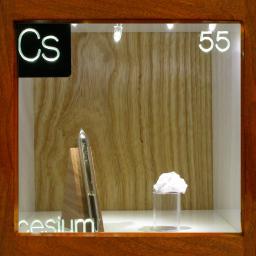Home Size: 1 2 3 4 5 6 7 8 9
|
 |
| A soft, shiny, pale golden alkali metal that is highly reactive igniting spontaneously in air. It melts easily if a sealed ampoule is (carefully!) held in the hand.
|
|
|
 |
Ampoule.
Cesium (or caesium as the British know it) is the most electropositive stable element. It is very keen to give up its single outer shell electron and pretend that it is xenon. Reportedly its reaction with water is so violent that the shock wave has been known to shatter a glass vessel. This is one reaction we have not yet tried! We have however carefully melted cesium as you can see on the accompanying video. Watch out for the exquisite ripples that form on its golden surface towards the end of the demonstration when the metal is entirely liquid. They have a very short wavelength and are quite unlike water or mercury.
Source: David Franco
Size: 1g
Purity: 99.9%
|
|
 |
Pollucite and Lepidolite.
Pollucite, named after the Greek mythological figure Pollux, is a gray, white, colorless, pale pink or blue mineral with a dull to vitreous lustre. It usually occurs in massive habit, only occasionally forming small crystals. There are only thirteen cesium minerals, of which pollucite is the richest. Lepidolite or lithium mica is colorless, gray, lilac, yellowish or white with a pearly or vitreous lustre. Its name stems from the Greek words lepidon (scale) and lithos (stone), alluding to its foliated or platy structure. Both pollucite and lepidolite are used as ores of their respective metals.
Source: Mackay mineral collection
Size: 0.5"
Purity: 28%
|
|
|

